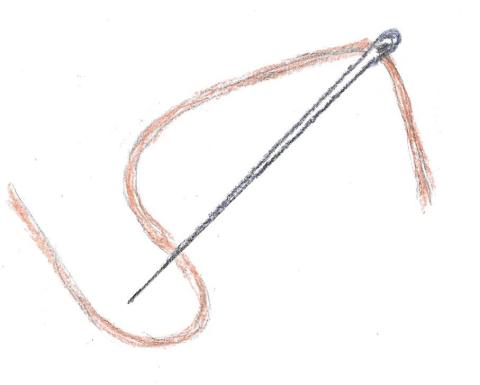Mending and Darning
When was the last time you sewed a button on a shirt? Do the heels of your socks need darning? What did you say? This is not a problem for you. Great! It was back in the day of the scrub board and those new-fangled wringer washers. I bet you haven't scorched a blouse recently either. Oh, you don't iron everything anymore? Sorry I asked. Let's get back to the good old days. Mending was a constant chore back then.
Several things worked against you in the clothing department. First of all, fabrics were either cotton, linen, maybe rayon, and wool. Nylon and polyester hadn't yet been invented. We all know that a cotton-polyester blend is stronger than plain cotton. Many fabrics today have a polyester blend to make them easier to care for - no ironing. Did I mention chlorine bleach? Not a friend of fabric.
Consider the methods of cleaning your clothes back in the day. The scrub board was harsh, but the real problems came from the wringer washing machine. That agitator put a hurting on your clothes, especially if you washed them too long or filled the tub with too many garments. It wouldn't take long for that “new clothes look” to disappear. Not putting a man's shirt carefully through the wringer could insure you later replacing buttons.
Back to mending. Can you put a respectable patch on the knees of your boy's jeans? There is a knack to that. Every housewife had a mending basket complete with patches of current family clothing and a darning egg. Let me tell you how to patch. First, select a patch of the same fabric and color shade as that holey knee. Trim the raw edges of the hole. Pin the patch underneath that spot and baste it in place. Now address the area, right side out. With your finger and needle turn under a small hem of the garment hole edge. With matching thread, take small stitches, securing the patch at that spot. Continue around the hole until the patch is firmly attached to the garment. Turn it inside out and sew the patch edge neatly to the body of the cloth. You are done. If you did a good job, the patch would last as long as the garment was wearable. On to the socks.
Darning socks is a lot like weaving. That is what you would be doing. At least that was the way I did it. Choose darning cotton the same color as the socks. Insert your darning “egg” into sock and form the hole over the egg. Sew a ring around the hole, before you start filling in the center, to give the area stability. Now, neatly draw your thread back and forth from one side to the other, stitching as close together as possible. When you get to the other side, start filling in at right angles, weaving back and forth again, almost like forming a new cloth at that spot. Keep your stitching smooth and even to make the darned patch as flat as possible. Resolve not to use so much bleach the next time. Or maybe, have a talk with your son about keeping his laces tighter so his shoes don't rub up and down on his heels. (Maybe you bought his shoes too big with the idea that he could wear them longer. Shame on you.)
Have you ever slept on patched sheets. Put the patched one on top. Those patches under your poor tired aching body leave imprints and not a little pain. Again, resolve to use less bleach in the next wash. As I have said before, “My, times have changed.”
- Log in to post comments
